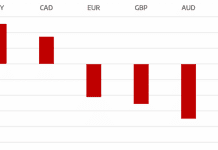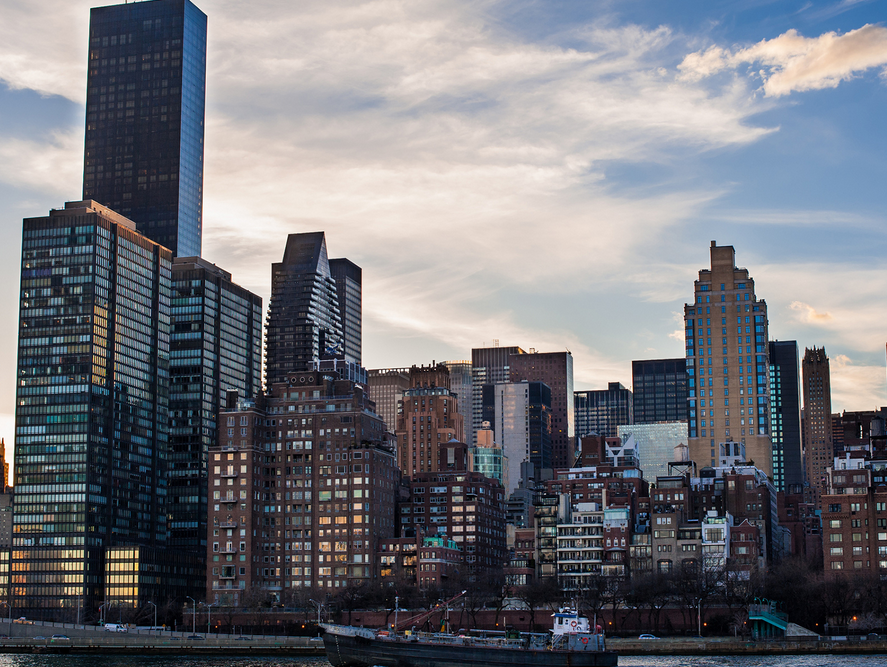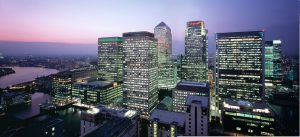
· World’s most valuable banking brands suffer severe decline in brand value following devastating effects of COVID-19 pandemic, two-thirds record brand value loss
· Chinese banks make up one-third of total brand value in Brand Finance Banking 500 2021 ranking, with ICBC retaining title of world’s most valuable banking brand – brand value US$72.8 billion
· Five US banks claim spots in top 10, with Bank of America highest ranked in 5th. JP Morgan is only bank in top 10 to record brand value growth, up 3%
· Vietnam’s banking sector sees greatest year-on-year brand value growth at 23%
· Union Bank of India is fastest growing in ranking, up by a staggering 163% to US$1.2 billion, following Andhra Bank and Corporation Bank amalgamation
· 23 new entrants in ranking this year, with Truist entering in 36th position
· Sber overtakes BCA to become world’s strongest banking brand, with a Brand Strength Index (BSI) score of 92.0 out of 100 and an elite AAA+ rating
As governments scramble to stimulate economic growth in the face of the ongoing global health crisis, and profits and interest rates take a hit, nearly two-thirds of the world’s 500 most valuable banking brands have recorded brand value losses, according to the latest report by Brand Finance – the world’s leading brand valuation consultancy, published by The Banker magazine today.
The industry has seen a dramatic downturn in the past two years when compared with previous year-on-year performance. The total brand value in the annual Brand Finance Banking 500 ranking increased by 10% in 2018 (from US$1.07 trillion to US$1.18 trillion) and again by 15% in 2019 (US$1.36 trillion) but decreased by 2% and 4% in 2020 (US$1.33 trillion) and 2021 (US$1.27 trillion), respectively.
The economic impacts of the COVID-19 pandemic are difficult to ignore, with global GDP forecasted to shrink by over 4%, which would signal the largest global recession since the Second World War.
Analyses conducted by Brand Finance on the world’s most valuable brands over three recessionary periods indicate that, on average, of the 100 brands that lost the most brand value during each recession, 74 of them were banks. On the other hand, of the 100 most successful brands during the recessions, 30 were banks.
Apart from calculating brand value, Brand Finance also determines the relative strength of brands through a balanced scorecard of metrics evaluating marketing investment, stakeholder equity, and business performance. Alongside revenue forecasts, brand strength is a crucial driver of brand value. Banks with a Brand Strength Index (BSI) score below 60 out of 100 experienced an average decline in brand value of 20%, whereas of the banks with a BSI score above 70, the average fall in brand value was only 8% – proving just how important it is for banks to have stronger brands than their competitors during an economic downturn.
David Haigh, CEO of Brand Finance, commented: “Banking institutions were the main culprit in the last financial crash; this time around they are a large part of helping people overcome the repercussions of COVID-19. Brand Finance research shows that banks’ responses to the global pandemic have led to a year-on-year increase in overall reputation scores among customers, which no doubt could result in an uptick in brand values in the coming year.”
“The widespread shift to digital has also opened up opportunities for banks to deliver better customer service and faster innovations, which goes a long way in enhancing brand awareness and value,” added Joy Macknight, managing editor of The Banker. “Those banks that have been investing time and resources in the digital transformation of their operations over the past few years have seen that investment pay off during the pandemic, as they were able to quickly respond to new customer needs.”
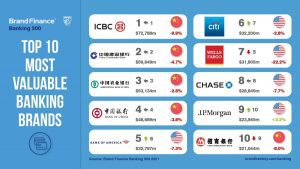
Chinese banks maintain dominance
Chinese banks maintain dominance of the Brand Finance Banking 500 2021 ranking, accounting for one-third of total brand value and seven of the ten top climbers by absolute brand value. Chinese banks have been largely impervious to the issues plaguing their counterparts elsewhere in the world – as two-thirds of brands in the ranking have experienced losses, Chinese banks recorded a healthy 3% average brand value growth. This is largely attributable to the banking sector’s role in China’s timely and effective response to COVID-19, which included regulatory policy adjustments for asset management, wealth management, and inter-banking, as well as increased investment into digitalisation.
Despite a 10% drop in brand value to US$72.8 billion, ICBC remains the world’s most valuable banking brand. As the biggest bank in China, ICBC continues to fare well with consumers, regardless of the bank’s depreciating brand value due to the pandemic’s negative impact on its investment portfolio return. Nonetheless, the brand maintains a healthy lead ahead of China Construction Bank (down 5% to US$59.6 billion) and Agricultural Bank of China (down 3% to US$53.1 billion), which come in at 2nd and 3rd place in the ranking, respectively.
China Guangfa Bank is also a remarkable addition to the country’s portfolio, entering the Brand Finance Banking 500 2021 ranking for the first time at an impressive 84th position and valued at US$3.3 billion. The Hong Kong Monetary Authority recently granted China Guangfa Bank a banking licence, widening its footprint outside of mainland China.
David Haigh, CEO of Brand Finance, commented: “Chinese banks have scored extremely well in Brand Finance’s Global Brand Equity Monitor research this year, ranking highly for attributes such as recommendation. This is undoubtedly an effect of China’s management of the COVID-19 pandemic, which has allowed its economy to continue functioning relatively unscathed, allowing space for banks to grow further.”
US banks five spots in top ten
US banks account for almost a quarter of the total brand value in the ranking – the nation’s 74 banks reaching a cumulative brand value of US$274.8 billion. Five US brands feature in the top 10: Bank of America (down 7% to US$32.8 billion), Citi (down 3% to US$32.2 billion), Wells Fargo (down 22% to US$31.8 billion), Chase (down 8% to US$28.8 billion), and JP Morgan (up 3% to US$23.6 billion). Bank of America remains the most valuable banking brand in the US, placing fifth overall, and JP Morgan is the only brand in the top 10 to record a positive value change.
Currently holding the lowest reputation score among all banks in the US, Wells Fargo experienced the largest decline in brand value – dropping two places to seventh overall, and third in the US – the result of failing to rebuild favour among customers in the wake of several past scandals.
Citi, the third largest US bank by assets, has emerged as the strongest retail bank in the US with a BSI score of 80.7 out of 100 and AAA- brand rating (up from AA+ in 2020). Citi has also climbed one place in the ranking to 6th position, following a rapid rebound in its profits in the third quarter of last year.
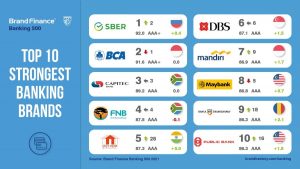
Spotlight on Vietnam
Vietnam’s banking sector has seen the greatest year-on-year brand value growth compared to any other nation in the ranking, standing at 23%. Vietnam’s ability to effectively control and constrain COVID-19 has allowed it to buck the sector-wide trend of declining brand value. Internal reforms have strengthened accountability of the Vietnamese financial sector, which has had the knock-on effect of boosting not just revenues, but brand reputation and trust. Vietnam’s banking sector has also recorded a 753% 5-year cumulative brand value growth, the second fastest national growth in the ranking.
Union Bank of India cashes in, up 163%
The Union Bank of India saw the fastest year-on-year growth of any bank globally, growing by 163% to US$1.2 billion and simultaneously soaring 128 places to claim 169th spot.
The amalgamation between Andhra Bank and Corporation Bank is primarily responsible for this growth – borne as part of a nationwide effort to consolidate India’s banking space. This success is also mirrored at the national level. Apart from China, India was the only nation in the top 10 countries by total brand value to see growth, with its cumulative brand value up 3% this year.
Ones to watch
While some of the world’s largest banks have floundered during the pandemic, 23 insurgent newcomers have joined the ranking, hailing from Europe, Asia, the US, and South America.
The highest new entrant is Truist at 36th position, with a brand value of US$8.0 billion. Formed in 2019 – a result of a merger between BB&T and SunTrust, which sat in 68th and 86th in the 2019 iteration of the Brand Finance Banking 500 ranking, respectively, with a combined brand value of US$7.2 billion. This merger is testament to the power of rebranding and a revised strategy, demonstrating that brands can be reinvigorated even in the face of a global crisis.
Sber overtakes BCA as sector’s strongest
Sber has been increasing in brand strength year-on-year to become the strongest brand in the Brand Finance Banking 500 2021 ranking and the world’s third strongest brand across all sectors in the Brand Finance Global 500, with a Brand Strength Index (BSI) score of 92.0 out of 100 and a coveted AAA+ brand strength rating.
As the largest bank in Russia, Sber has benefitted from its stable brand and high levels of customer loyalty. These have only been boosted by the recent rebranding to consolidate its ecosystem of services – encompassing banking, health, and logistics, among others – around the Sber brand. Sber is poised for further success, as the company’s pledge to spend more on its brand in the coming year is likely to further boost its BSI score.
In Brand Finance’s original market research, Sber consistently outperforms its peers in overall reputation and familiarity – it is widely known, always top-of-mind, and well-regarded. As a result, recommendation is high. Its ubiquitous presence and – in consumers’ eyes – by far the best digital offering ensure high mental and physical availability, which are strong foundations for brand strength.
David Haigh, CEO of Brand Finance, commented: “Sber’s successful rebranding as a cross-sector tech brand can be an example to other market leaders worldwide. While some rest on their laurels and are often surprised by disruptive challengers, Sber is focused on the future, innovating and modernising with their customers’ best interests in mind.
HedgeThink.com is the fund industry’s leading news, research and analysis source for individual and institutional accredited investors and professionals


































